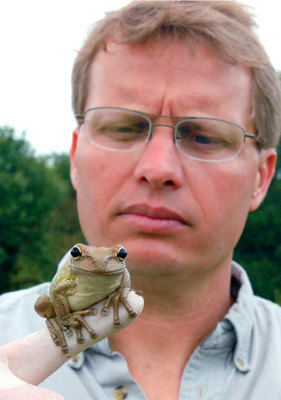It sounds like the plot of a B movie.
People scream after finding huge frogs in their toilet bowls. Electrified amphibians cause multiple blackouts. Frogs hitch rides in cars, later surprising unsuspecting drivers.
It's all real, and, according to the University of Florida, the invasive Cuban tree frog is responsible for the chaos. The species has colonized over half of Florida and is now moving in on the rest of the state. The 6-inch-long frogs, which dwarf native tiny tree frogs, have also been found in Georgia, South Carolina, California, Hawaii and Canada.

|
| ©AP photo/University of Florida/IFAS/Josh Wickham
|
| In this photo, Steve Johnson holds a Cuban tree frog at the Gulf Coast Research and Education Center in Plant City. The invasive frog, which can be more than six inches long, has colonized the southern half of the state and is moving north.
|
UF amphibian expert Steve Johnson told Discovery News that the frog "toilet surprise" has startled himself, numerous students and several friends.
"They come in through bathroom PVC vent pipes on the roof," Johnson explained. "Once they find moisture, they may just keep moving down until they make their way to the toilet, one of their favorite indoor destinations."
He added that the creamy white to light brown frogs can also clog up sinks. The bathroom attraction has to do with the frogs' preference for "confined, cozy" spaces, such as pipes.
The frogs first became established in Florida in the early 20th century, after the amphibians stowed away on boats. On land, almost any form of transportation can carry them from one region to another.
Johnson said Florida, California and Hawaii remain particularly vulnerable to such invasions.
The states contain numerous ports of entry. The problem also worsens, thanks to a "booming" pet trade. Johnson said he has seen Cuban tree frogs for sale at major U.S. pet store chains, despite the fact that the species releases a mild toxin from its skin that can burn the eyes of handlers.
When people tire of their exotic pet, they may then release it into the wild, thus adding to the invasive species problem.
The frogs then thrive in Florida's wetlands, not to mention the year-round warm conditions.
Among the many problems the invasive frogs cause are electrical outages.
Steve Perkins, system operations engineer at the state's third largest public power utility, suggests that while the frogs have been around for decades, their numbers must be on the rise. Since the mid 1990's, the frogs have caused two or three blackouts per week during the spring and fall.
Perkins thinks power poles attract the Cuban frogs because the poles provide shelter and may house insects. Once inside, the frog may contact two surfaces. If one or both of these surfaces carries an electrical charge, the amphibian can disrupt the normal flow of electricity, leading not only to a fried frog but also a power outage. He said a single incident can cost up to $10,000 to repair.
Native frogs never cause outages, Perkins said, because they are too small to contact charged surfaces that are spread apart.
Johnson is working on two possible solutions. The first involves capturing the frogs in PVC pipes and humanely euthanizing them. The second employs a chemical deterrent, now used to repel chewing horses and porcupines. Johnson said the repellent's key chemical is commonly found in newspaper ink.
He admits those are just Band-Aid solutions.
"Once an invasive species becomes established, it's next to impossible to eradicate it," Johnson said. "That's why it's important to detect populations of invasive plants and animals early, before it's too late."
Reader Comments
to our Newsletter